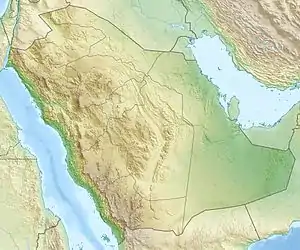Jabal al-Lawz
Jabal al-Lawz (Arabic: جَبَل ٱللَّوْز), also known as Gebel el-Lawz, is a mountain located in northwest Saudi Arabia, near the Jordanian border, above the Gulf of Aqaba at 2,580 metres (8,460 feet) above sea level. The name means 'mountain of almonds'.[2] The peak of Jabal al-Lawz, consists of a light-colored, calc-alkaline granite that is intruded by rhyolite and andesite dikes which generally trend eastward.[3]
| Jabal al-Lawz | |
|---|---|
 Jabal al-Lawz Location in Saudi Arabia | |
| Highest point | |
| Elevation | 2,580 m (8,460 ft) [1] |
| Prominence | 1,622 m (5,322 ft) [1] |
| Listing | Ultra |
| Coordinates | 28°39′15″N 35°18′21″E [1] |
| Naming | |
| Native name | جَبَل ٱللَّوْز (in Arabic) |
| English translation | mountain of almonds |
| Geography | |
| Location | Saudi Arabia |
Between 1300 and 2200 meters elevation, Jabal al-Lawz has relict Mediterranean woodlands of Juniperus phoenicea, with an understory of Achillea santolinoides, Artemisia sieberi, and Astracantha echinus subsp. arabica.[4]
In discussions about the location of biblical Mount Sinai, Jabal Maqlā ('Burnt Mountain') is often believed to be Jabal al-Lawz by various authors such as Bob Cornuke, Ron Wyatt, and Lennart Möller as shown by local and regional maps[3] and noted by other investigators.[5] In contrast to the real Jabal al-Lawz, the summit of Jabal Maqlā consists mainly of dark-colored hornfels derived from metamorphosed volcanic rocks that originally were silicic and mafic lava flows, tuff breccias, and fragmental greenstones. The middle and lower slopes of Jabal Maqlā consist of light-colored granite, which has intruded into the overlying hornfels. This is the same granite that comprises Jabal al-Lawz.[3] Jabal Maqla is about 7 kilometers to the south, and a few hundred meters lower.
Claims made by some writers, including Bob Cornuke, Ron Wyatt, and Lennart Moller, that Jabal Maqlā, possibly misidentified as Jabal al-Lawz, is the real biblical Mount Sinai have been rejected by such scholars as James Karl Hoffmeier (Professor of Old Testament and Ancient Near Eastern History and Archaeology), who details what he calls Cornuke's "monumental blunders".[2][6] Creationist Gordon Franz has also argued against this identification.[7][8]
Remains both of pillars and cairns at the site have been described as "similar to rock cairns of uncertain use and often uncertain date found at other sites throughout northern and western Arabia."[9]
See also
References
- "Arabian peninsula and Middle East" Peaklist.org. Retrieved 2013-07-04.
- Hoffmeier, James Karl Ancient Israel in Sinai Oxford University Press USA 2005 ISBN 978-0-19-515546-4 p133
- Trent, V.A., and R.F. Johnson (1967) Geologic map of the Jabal al Lawz Quadrangle, Kingdom of Saudi Arabia; 1:100,000. Mineral Investigation Map MI-13. United States Geological Survey, Reston, Virginia, and Mineral Resources Research, Directorate General of Mineral Resources. Saudi Arabia.
- S.A. Ghazanfar, M. Fisher (2013). Vegetation of the Arabian Peninsula. Springer Science & Business Media, Apr 17, 2013.
- Caldwell, J., and P. Caldwell (2011) The Real Mount Sinai. Split Rock Research Foundation, Diamondhead, Mississippi. 60 pp.
- Jameson, John H. John E. Ehrenhard, Christine Finn Ancient muses: archaeology and the arts University of Alabama Press (30 Jun 2003) ISBN 978-0-8173-1274-9 p.179
- Mount Sinai is NOT Jebel al-Lawz Archived 2015-11-19 at the Wayback Machine, Oct 03, 2007, by Gordon Franz MA, Associates for Biblical Research website Archived 2015-11-13 at the Wayback Machine.
- Is Mount Sinai in Saudi Arabia? Archived 2010-06-22 at the Wayback Machine, Jun 10, 2008, by Gordon Franz MA, Associates for Biblical Research website Archived 2015-11-13 at the Wayback Machine. (alternate cite: Is Mount Sinai in Saudi Arabia? July 1, 2006.)
- Allen Kerkeslager (1998). "Jewish Pilgrimage and Jewish Identity". In Frankfurther, David (ed.). Pilgrimage and Holy Space in Late Antique Egypt. Brill. p. 212. ISBN 978-9004111271. Retrieved 2015-12-29.
.jpg.webp)


